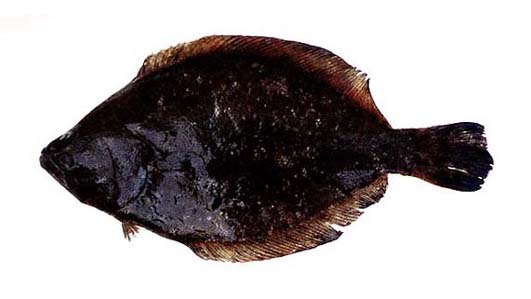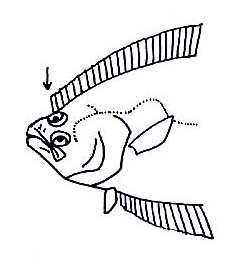ダルマガレイ科
- HOME
- デジタル図鑑
- パタゴニア海域の重要水族
- 硬骨魚綱 カレイ目
- ダルマガレイ科
ダルマガレイ科(Bothidae)

119 チリヒラメ(Chiri-hirame)
Paralichthys microps(Günther, 1881)
Lenguado de ojo chico(Ch.)
特 徴:
背鰭71〜80軟条,臀鰭57〜64軟条,胸鰭11〜13軟条,腹鰭1棘,5軟条,鰓耙数8〜10+19〜23=28〜33,鰓条骨数7,側線鱗線90〜103。頭長は体長は28.2〜31.6%,眼径は3.1〜3.5%,肉質眼窩は4.2〜5.0%,体高は44.6〜46.2%,吻長は5.8〜6.6%,両眼間隔は2.6〜3.5%,上顎長は12.4〜14.0%,尾柄高は11.0〜12.3%,胸鰭長は12.1〜14.6%,腹鰭長は6.2〜8.4%,背鰭高は11.7〜14.1%,臀鰭高は11.0〜13.7%。体は楕円形で,著しく縦扁し,体長は体高の2.2〜2.4倍。頭は大きく,体長は頭長の3.2〜3.6倍。吻はやや長く,吻長は眼径よりやや大きい。頭部上縁はわずかに凹む。眼は小さく,頭長は眼径の7〜8倍,上眼は下眼よりやや前方に位置する。口は大きくて,斜位。上顎後端は下眼後縁下に達する。両顎はほぼ同長。両顎歯は犬歯状で1列に並び,前半部の歯は後半部の歯より大きくて頑丈。鰓耙は長くて細長い。擬鰓がある。有眼側の一対の鼻孔は小さく,前鼻孔は丸く後縁に皮弁を有し,後鼻孔は卵円形で皮弁を有しない。無眼側の一対の鼻孔も小さく,背縁近くに位置し,前鼻孔は丸く後縁に皮弁を有し,後鼻孔は丸く後縁に皮弁を有しない。両眼間隔域は平坦で狭く,その幅は眼径より小さい。背鰭起部は上眼の中央上方に位置する。胸鰭は短く,有眼側では頭長の約半分,無眼側では頭長の約1/3。腹鰭は短く,両側でほぼ同大。尾鰭後縁は二凹形。有眼側の鱗は櫛鱗で,無眼側の鱗は円鱗。側線は単線で,前半部に分枝と湾曲を有し,後半部はほぼ直線状。
分 布:
チリ沿岸。
備 考:
背鰭起部の位置で本種はHippoglossina属のある種に近いようだが,歯の形,臀鰭棘を欠くことなどで,やはりParalichthys属に入れるのが妥当(Norman, 1943)。
(中村 泉)
Material examined:
8 from Chile (155.3-254.5 mm SL), FAKU CP 189, 371, 372, 627-629, 631, 632.
Description:
D 71-80; A 57-64; P111-13; P2 I, 5; GR 8-10+19-23=28-33; BR 7; LLS 90-103.
HL 28.2-31.6% of SL; ED 3.1-3.5; FO 4.2-5.0; BD 44.6-46.2; SN 5.8-6.6; IO 2.6-3.5; UJ 12.4-14.0; CP 11.0-12.3; P1L 12.1-14.6; P2L 6.2-8.4; DH 11.7-14.1; AH 11.0-13.7.
Body elliptical and well depressed, body depth 2.2-2.4 times in SL. Head large, 3.2-3.6 times in SL. Snout Slightly larger than eye diameter. Upper profile of head slightly concave. Eye small, 7-8 times in head, upper eye slightly anterior to lower eye. Mouth oblique, large, posterior margin of upper jaw reaching posterior margin of lower eye. Lower jaw not projected. Small uniserial caniniform teeth on both jaws, anterior teeth larger and stronger than posterior teeth. Gill-rakers long, slender. Pseudobranchiae present. Nostrils on ocular side small; anterior nostril round with a flap posteriorly, posterior nostril oval without flap. Nostrils on blind side small, situated near dorsal margin; anterior nostril round with a flap posteriorly and posterior nostril round. Interorbital region fairly flat and narrow, its width shorter than eye diameter. Dorsal fin originating above middle of upper eye. Pectoral fins small, about half of head on ocular side, about one-third of head on blind side. Pelvic fins on both sides subequal. Caudal fin double truncate. Scales ctenoid on ocular side and cycloid on blind side. Lateral line with a branch and a curving anteriorly and fairly straight posteriorly.
Distribution:
Coast of Chile.
Remarks:
In the position of the dorsal fin origin P. microps approaches some of the species of Hippoglossina, but the form of the teeth and the absence of an anal spine suggest that it belongs to Paralichthys (Norman, 1943).
(Izumi NAKAMURA)

Distribution of Paralichthys microps in Patagonia.

Head. Dorsal fin origin arrowed.